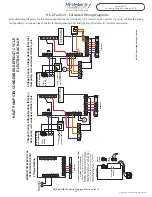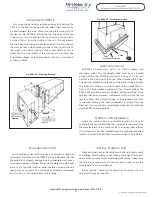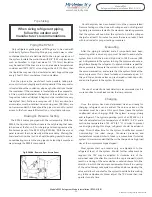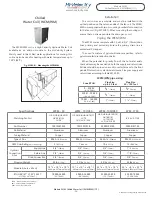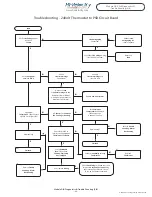
www.hi-velocity.com
© 1995-2017 Energy Saving Products Ltd.
Module OPT
Add-Ons & Third Party Options (2/2)
Module OPT Add-Ons & Third Party Options (2/2)
Fig. OPT-04 – Fire Stopping Devices
For areas that require fresh air make-up, a small intake may
have to be installed. It is recommended to install an insulated flex
duct, with a damper, into the return air plenum. The damper can
then be adjusted to supply the exact amount of fresh air needed to
meet local building codes (Fig. OPT-03). This should be balanced
to the exhaust air levels of the structure. Either filter the combined
air stream through a common filter or use separate filters for both
air streams.
Install the fresh air duct to the side of the return air and not
directly into the air stream. As shown in Fig. 03, the fresh air duct
should be installed more than 6’ (1.8m) away from the fan coil and
before a 90º bend.
If too large of a duct is installed, the excess fresh air will increase
system operating costs and decrease system performance.
Some areas require a Fire Stopping device to stop the spread of
a fire and/or prevent the duct system from supplying oxygen to
the fire. The Hi-Velocity System can be used in conjunction with
several types of Fire Stopping devices such as pipe collars, wrap
strips and mechanical shut-offs.
With our Rough-In Boots, Metacaulk
pipe collars work very well; Fig. OPT-
04 gives an illustration of a pipe collar
used with the Rough-In Boot. Many
options are available to the designer. If
assistance is needed in product choice,
call our representatives at Energy
Saving Products for free technical
advice.
Fig. OPT-05 – Humidifier
18”
When a bypass type humidifier is
used, the humidifier can be mounted on
the return air duct, and then a 2” (51mm)
take-off from the hot air side is run back
(Fig. OPT-05). DO NOT use any size
larger than 2” (51mm), and be sure to
install a summer shut-off, or it will create
problems with the airflow.
Fresh Air Make-Up
Fire Stopping
Humidity Control
Third Party Options
Fig. OPT-03 – Fresh Air Make up
Exterior
Intake
Insulated Fresh Air Intake
Adjustable
Damper
Install at least 6’ (1.8m) away from fan coil,
not directly into the air stream, to allow fresh
air to mix with the return air. A P-Trap of at
least 3’ (914mm) in depth should be installed
to stop the migration of air.
P-Trap
An approximate fresh air duct sizing is: 3” (76mm) for the 50
unit, 4” (102mm) for the 70 unit, and 5” (127mm) for the 100 unit.
An HRV (Heat Recovery Ventilator) is typically a flat-plate air-
to-air heat exchanger that transfers temperature between the two
air streams. An ERV (Energy Recovery Ventilator) will exchange
water vapour as well as temperature. It is usually a “heat wheel”
and some amount of air will leak between the two airstreams. It
is generally more costly than an HRV but it has the advantage of
reducing the latent capacity and not just the sensible capacity.
HRV/ERV
There are several ways to integrate these products into
the Hi-Velocity System. The easiest is to draw the exhaust from
the return duct and then to add the fresh air a minimum of 5’
downstream.
However, the best method is to have a separate return for the
exhaust air. This will minimize any short circuiting of air between
the fresh air and the exhaust, optimizing the location of the
exhaust returns, which are best located in bathrooms.
-41-
It is recommended to use a steam
humidifier in single zone applications.
For multi-zone applications, contact the
manufacturer.


